会计专业英语复习资料汇总
- 格式:docx
- 大小:15.57 KB
- 文档页数:7

会计的基本英语知识点汇总1. Introduction to Accounting会计简介Accounting is the systematic process of identifying, recording, measuring, classifying, summarizing, interpreting, and communicating financial information. It plays a crucial role in the management and decision-making processes of businesses and organizations.会计是一种系统性的流程,用于识别、记录、度量、分类、总结、解释和传达财务信息。
它在企业和组织的管理和决策过程中发挥着至关重要的作用。
2. Basic Accounting Principles基本会计原则There are several fundamental principles that underpin the field of accounting:有几个基本原则支撑着会计领域:a) Accrual Principle: This principle states that financial transactions should be recorded when they occur and not when the cash is received or paid out.应计原则:该原则规定财务交易应在其发生时记录,而不是在现金收到或支付时记录。
b) Matching Principle: This principle states that expenses should be recognized in the same accounting period as the revenues they help generate.配比原则:该原则规定支出应在与其相关的收入产生的同一会计期间内确认。
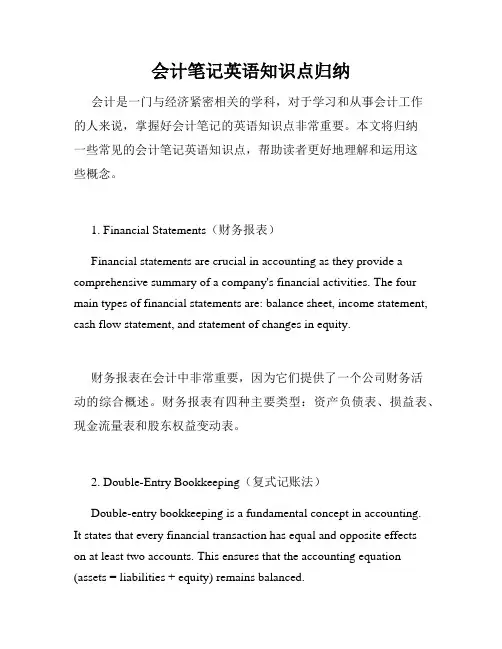
会计笔记英语知识点归纳会计是一门与经济紧密相关的学科,对于学习和从事会计工作的人来说,掌握好会计笔记的英语知识点非常重要。
本文将归纳一些常见的会计笔记英语知识点,帮助读者更好地理解和运用这些概念。
1. Financial Statements(财务报表)Financial statements are crucial in accounting as they provide a comprehensive summary of a company's financial activities. The four main types of financial statements are: balance sheet, income statement, cash flow statement, and statement of changes in equity.财务报表在会计中非常重要,因为它们提供了一个公司财务活动的综合概述。
财务报表有四种主要类型:资产负债表、损益表、现金流量表和股东权益变动表。
2. Double-Entry Bookkeeping(复式记账法)Double-entry bookkeeping is a fundamental concept in accounting.It states that every financial transaction has equal and opposite effectson at least two accounts. This ensures that the accounting equation (assets = liabilities + equity) remains balanced.复式记账法是会计中的一个基本概念。
它指出每一笔财务交易对至少两个账户产生相等且相反的影响。
这样可以确保会计方程式(资产=负债+所有者权益)保持平衡。
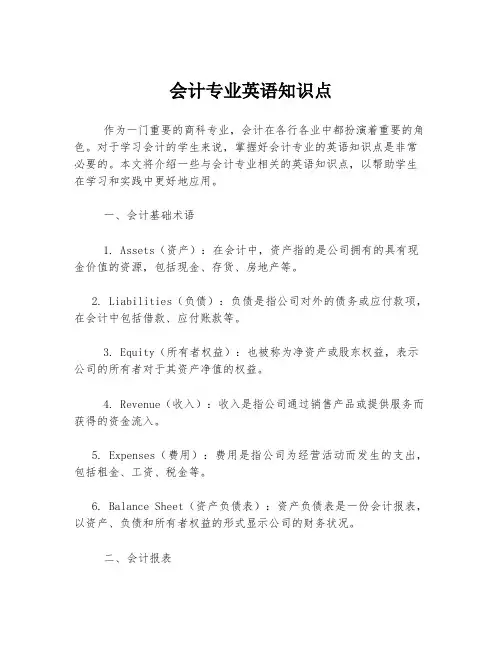
会计专业英语知识点作为一门重要的商科专业,会计在各行各业中都扮演着重要的角色。
对于学习会计的学生来说,掌握好会计专业的英语知识点是非常必要的。
本文将介绍一些与会计专业相关的英语知识点,以帮助学生在学习和实践中更好地应用。
一、会计基础术语1. Assets(资产):在会计中,资产指的是公司拥有的具有现金价值的资源,包括现金、存货、房地产等。
2. Liabilities(负债):负债是指公司对外的债务或应付款项,在会计中包括借款、应付账款等。
3. Equity(所有者权益):也被称为净资产或股东权益,表示公司的所有者对于其资产净值的权益。
4. Revenue(收入):收入是指公司通过销售产品或提供服务而获得的资金流入。
5. Expenses(费用):费用是指公司为经营活动而发生的支出,包括租金、工资、税金等。
6. Balance Sheet(资产负债表):资产负债表是一份会计报表,以资产、负债和所有者权益的形式显示公司的财务状况。
二、会计报表1. Income Statement(利润表):利润表显示了公司在一定期间内的收入、费用和净利润。
2. Cash Flow Statement(现金流量表):现金流量表反映了公司在一定期间内现金收入、现金支出以及现金净增加额。
3. Statement of Retained Earnings(留存收益表):留存收益表展示了公司在一定期间内的净利润和分红情况。
4. Statement of Changes in Equity(权益变动表):权益变动表展示了公司在一段时间内所有者权益的变化情况,包括净利润、股东投资等。
三、审计和税务1. Audit(审计):审计是对公司财务报表和财务记录的全面审核和检查。
2. Taxation(税务):税务是指涉及支付税款和申报纳税义务的活动,包括个人所得税、企业所得税等。
3. Tax Return(纳税申报表):纳税申报表是个人或企业向税务机关报告收入和纳税情况的文件。
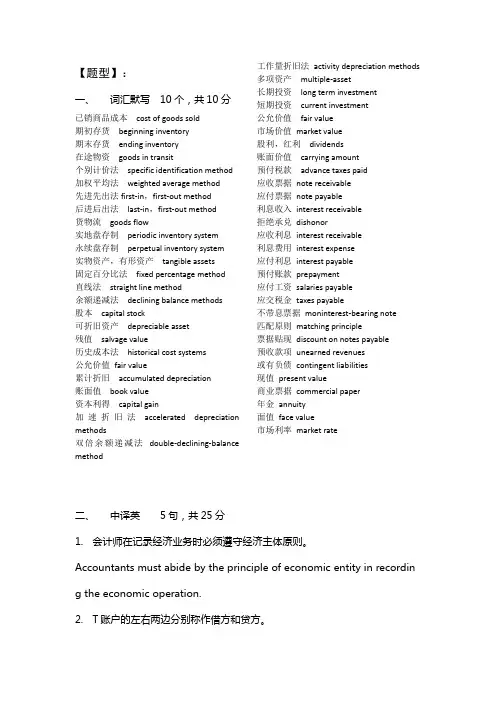
【题型】:一、词汇默写10个,共10分已销商品成本cost of goods sold期初存货beginning inventory期末存货ending inventory在途物资goods in transit个别计价法specific identification method 加权平均法weighted average method先进先出法first-in,first-out method后进后出法last-in,first-out method货物流goods flow实地盘存制periodic inventory system永续盘存制perpetual inventory system实物资产,有形资产tangible assets固定百分比法fixed percentage method直线法straight line method余额递减法declining balance methods股本capital stock可折旧资产depreciable asset残值salvage value历史成本法historical cost systems公允价值fair value累计折旧accumulated depreciation账面值book value资本利得capital gain加速折旧法accelerated depreciation methods双倍余额递减法double-declining-balance method 工作量折旧法activity depreciation methods 多项资产multiple-asset长期投资long term investment短期投资current investment公允价值fair value市场价值market value股利,红利dividends账面价值carrying amount预付税款advance taxes paid应收票据note receivable应付票据note payable利息收入interest receivable拒绝承兑dishonor应收利息interest receivable利息费用interest expense应付利息interest payable预付账款prepayment应付工资salaries payable应交税金taxes payable不带息票据moninterest-bearing note匹配原则matching principle票据贴现discount on notes payable预收款项unearned revenues或有负债contingent liabilities现值present value商业票据commercial paper年金annuity面值face value市场利率market rate二、中译英5句,共25分1.会计师在记录经济业务时必须遵守经济主体原则。
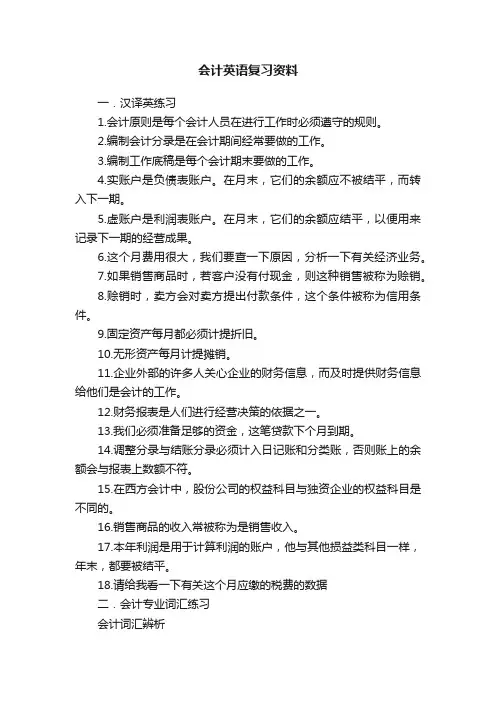
会计英语复习资料一.汉译英练习1.会计原则是每个会计人员在进行工作时必须遵守的规则。
2.编制会计分录是在会计期间经常要做的工作。
3.编制工作底稿是每个会计期末要做的工作。
4.实账户是负债表账户。
在月末,它们的余额应不被结平,而转入下一期。
5.虚账户是利润表账户。
在月末,它们的余额应结平,以便用来记录下一期的经营成果。
6.这个月费用很大,我们要查一下原因,分析一下有关经济业务。
7.如果销售商品时,若客户没有付现金,则这种销售被称为赊销。
8.赊销时,卖方会对卖方提出付款条件,这个条件被称为信用条件。
9.固定资产每月都必须计提折旧。
10.无形资产每月计提摊销。
11.企业外部的许多人关心企业的财务信息,而及时提供财务信息给他们是会计的工作。
12.财务报表是人们进行经营决策的依据之一。
13.我们必须准备足够的资金,这笔贷款下个月到期。
14.调整分录与结账分录必须计入日记账和分类账,否则账上的余额会与报表上数额不符。
15.在西方会计中,股份公司的权益科目与独资企业的权益科目是不同的。
16.销售商品的收入常被称为是销售收入。
17.本年利润是用于计算利润的账户,他与其他损益类科目一样,年末,都要被结平。
18.请给我看一下有关这个月应缴的税费的数据二.会计专业词汇练习会计词汇辨析()Dividends ()Cash()Inventory ()Accumulated depreciation()Accounts receivable ()Interest payable()Income taxes payable ()Owner’s capital()Retained earnings ()Closing entry()Journalizing ()Administrative expenses()Cost of goods sold ()Net income()Business transaction ()Unearned revenues()Ending balance ()Financial expenses()Prepaid expenses ()operating results()Withdrawals ()Sales( )Allowance for bad accounts ()Common stock()Office supplies inventory ()long-term bonds investments ()Accounts payable ()Cash basis accounting ()Office equipments ()Posting()Beginning balance ()Business transaction()Trial balance ()Financial statements()Selling expenses. ()Financial position()Marketable securities ( ) paid in capital( ) operating equipments ()Notes payable( ) Short term investment ( ) Gain()Extraordinary items ()Finished products()Salary expenses ()Interest receivable()Accrual basis accounting ()Income statements()Adjusting entry ()Intangible assets( ) Source documents ( ) Gross sales( ) Purchase ( ) Fixed assets1.期末余额28. 坏账准备2.应付所得税29. 应收账款3.销售费用30. 主营业务收入4.业主资本31. 经营成果5.主营业务成本32 管理费用6.应付利息33 存货7.留存收益34 调整分录8.预收账款35 结账分录9.累计折旧36 权责发生制10.经济业务37 应付票据11.财务报表38 编制分录12.试算平衡39. 期初余额13.现金收付制40. 应付账款14.财务费用41. 净利润15.普通股42. 财务状况16.营业外收支项目43. 过账17.应收利息44 办公用品库存18.实收资本45. 办公设备19.库存46. 股利20.经营设备47. 业主提取21.利得48. 产成品22.待摊费用49. 交易性金融资产23.长期债券投资50. 短期投资24.无形资产51. 工资费用25.生产设备52销售总额26.原始凭证53 固定资产27.采购54. 工资费用三.英译汉1.Revenue is the price of goods sold and services rendered during a given accounting period. Earning revenue causes owner’s equity to increase. When a business renders services of sells merchandise to its customers, it usually receives cash or acquires an account receivable from the customer.2.To clearly identify the effects of the business operations on each of the accounting elements, it is necessary to transfer those records from journal to each corresponding books used for recording different accounting element. This transfer process is called “posting”.3.The journal is a day-by-day record of business transactions. The information recorded about each transaction includes the date of the transaction, the debit and credit changes in specific ledger accounts, and a brief explanation of the transaction.4.The things a business owns can be classified into five categories, which also called accounting elements, they are: assets, liabilities, owners' equity, revenues, and expenses. Every business transaction of the business may affect more than one of the above elements。
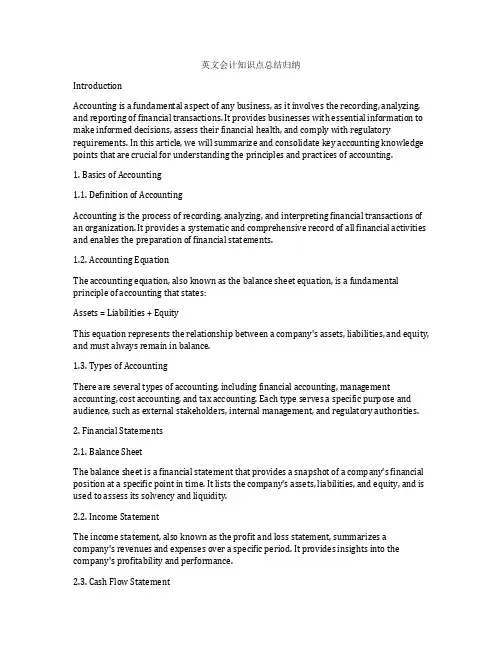
英文会计知识点总结归纳IntroductionAccounting is a fundamental aspect of any business, as it involves the recording, analyzing, and reporting of financial transactions. It provides businesses with essential information to make informed decisions, assess their financial health, and comply with regulatory requirements. In this article, we will summarize and consolidate key accounting knowledge points that are crucial for understanding the principles and practices of accounting.1. Basics of Accounting1.1. Definition of AccountingAccounting is the process of recording, analyzing, and interpreting financial transactions of an organization. It provides a systematic and comprehensive record of all financial activities and enables the preparation of financial statements.1.2. Accounting EquationThe accounting equation, also known as the balance sheet equation, is a fundamental principle of accounting that states:Assets = Liabilities + EquityThis equation represents the relationship between a company's assets, liabilities, and equity, and must always remain in balance.1.3. Types of AccountingThere are several types of accounting, including financial accounting, management accounting, cost accounting, and tax accounting. Each type serves a specific purpose and audience, such as external stakeholders, internal management, and regulatory authorities.2. Financial Statements2.1. Balance SheetThe balance sheet is a financial statement that provides a snapshot of a company's financial position at a specific point in time. It lists the company's assets, liabilities, and equity, and is used to assess its solvency and liquidity.2.2. Income StatementThe income statement, also known as the profit and loss statement, summarizes a company's revenues and expenses over a specific period. It provides insights into the company's profitability and performance.2.3. Cash Flow StatementThe cash flow statement tracks the inflow and outflow of cash within an organization. It categorizes cash flows into operating, investing, and financing activities, and helps assess the company's ability to generate cash and meet its obligations.3. Principles of Accounting3.1. Accrual Basis vs. Cash Basis AccountingAccrual basis accounting recognizes revenues and expenses when they are incurred, regardless of when cash is exchanged. Cash basis accounting, on the other hand, records transactions only when cash is received or paid. Accrual basis accounting provides a more accurate representation of a company's financial performance.3.2. Matching PrincipleThe matching principle requires that expenses be recognized in the same period as the revenues to which they relate. This principle ensures that a company's financial statements accurately reflect its profitability.3.3. Revenue RecognitionRevenue recognition dictates when and how revenue should be recorded in a company's financial statements. It is crucial for determining a company's financial performance and must adhere to generally accepted accounting principles (GAAP).4. Assets and Liabilities4.1. Types of AssetsAssets are resources owned by a company and can be categorized into current assets (e.g., cash, inventory) and non-current assets (e.g., property, plant, and equipment). Understanding the nature and value of an organization's assets is vital for assessing its financial health.4.2. Types of LiabilitiesLiabilities represent an organization's obligations to outside parties and can include accounts payable, long-term debt, and accrued expenses. Managing and tracking liabilities is crucial for maintaining financial stability.5. Internal Controls5.1. Importance of Internal ControlsInternal controls are processes and procedures that a company implements to safeguard its assets, ensure accuracy in financial reporting, and comply with regulations. They help prevent fraud, errors, and mismanagement of funds.5.2. Segregation of DutiesSegregation of duties involves dividing responsibilities among different individuals to prevent the occurrence of fraud and errors. It ensures that no single individual has control over critical financial processes.6. Auditing6.1. Purpose of AuditingAuditing is the process of examining a company's financial statements and accounting records to ensure accuracy, integrity, and compliance with laws and regulations. It provides independent assurance to stakeholders regarding the company's financial performance.6.2. Types of AuditsThere are different types of audits, such as external audits conducted by independent accounting firms, internal audits performed by a company's internal audit department, and government audits carried out by regulatory agencies.7. Taxation7.1. Tax PlanningTax planning involves the structuring of financial activities to minimize tax liabilities within the boundaries of the law. It requires an in-depth understanding of tax laws, regulations, and incentives.7.2. Tax Deductions and CreditsUnderstanding tax deductions and credits is essential for businesses to optimize their tax positions and reduce their tax burden. Deductions lower taxable income, while credits directly reduce the amount of tax owed.8. Financial Analysis8.1. Ratio AnalysisRatio analysis involves the use of financial ratios to evaluate a company's performance, liquidity, solvency, and efficiency. Common ratios include profitability ratios, liquidity ratios, and leverage ratios.8.2. Trend AnalysisTrend analysis involves comparing financial data over different periods to identify patterns, changes, and potential areas for improvement. It helps in assessing a company's financial health and predicting future performance.ConclusionAccounting is a critical aspect of business that provides insights into an organization's financial performance, health, and compliance. Understanding the basics of accounting, financial statements, principles, assets and liabilities, internal controls, auditing, taxation, and financial analysis is essential for business owners, managers, and financial professionals to make informed decisions and ensure the financial success of their organizations. By consolidating and summarizing these key accounting knowledge points, individuals can gain a comprehensive understanding of the principles and practices of accounting.。
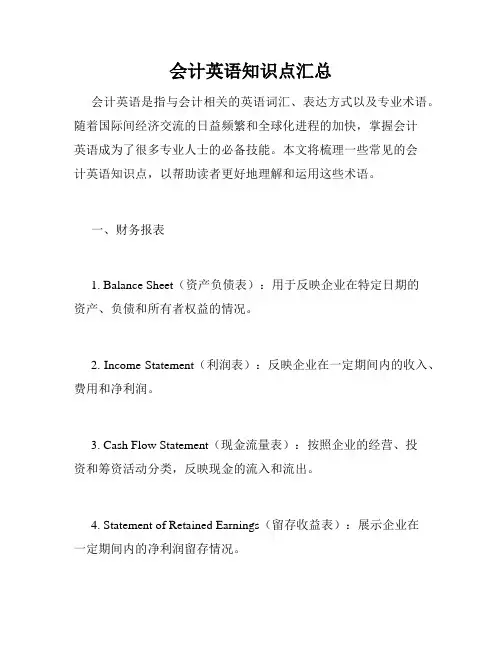
会计英语知识点汇总会计英语是指与会计相关的英语词汇、表达方式以及专业术语。
随着国际间经济交流的日益频繁和全球化进程的加快,掌握会计英语成为了很多专业人士的必备技能。
本文将梳理一些常见的会计英语知识点,以帮助读者更好地理解和运用这些术语。
一、财务报表1. Balance Sheet(资产负债表):用于反映企业在特定日期的资产、负债和所有者权益的情况。
2. Income Statement(利润表):反映企业在一定期间内的收入、费用和净利润。
3. Cash Flow Statement(现金流量表):按照企业的经营、投资和筹资活动分类,反映现金的流入和流出。
4. Statement of Retained Earnings(留存收益表):展示企业在一定期间内的净利润留存情况。
二、会计核算1. Accounting Equation(会计等式):Assets(资产)= Liabilities(负债)+ Owner's Equity(所有者权益),反映了企业财务状况的基本平衡关系。
2. Depreciation(折旧费用):用于反映资产价值随时间的减少。
3. Accrual Accounting(权责发生制):将收入和费用与实际发生的时间匹配,而非支付和收入的时间。
4. Double-entry Bookkeeping(复式记账法):每笔交易必须同时记录借方和贷方的金额。
5. Financial Ratios(财务比率):用于分析企业财务状况和经营绩效的指标,包括盈利能力、杠杆比率、偿债能力等。
三、财务分析1. Liquidity(流动性):反映企业偿付短期债务的能力。
2. Solvency(偿债能力):反映企业偿付长期债务的能力。
3. Profitability(盈利能力):反映企业获取利润的能力。
4. Efficiency(效率):反映企业运营资源利用的程度。
5. DuPont Analysis(杜邦分析):将利润率、资产周转率和资本结构相互关联,分析企业绩效因素。
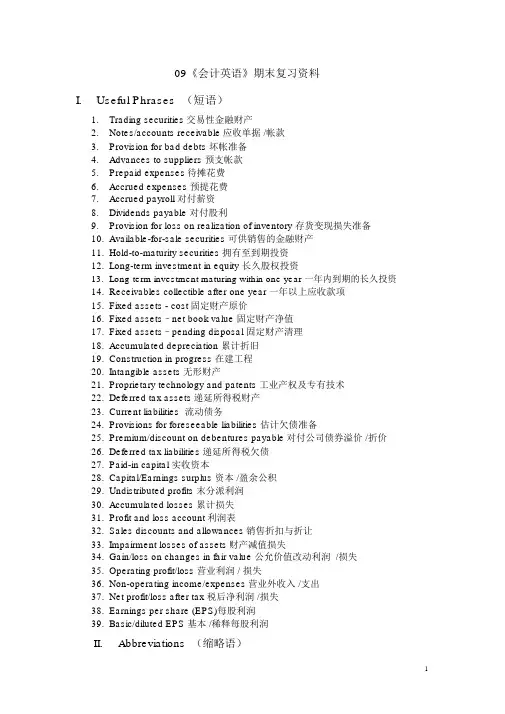
09《会计英语》期末复习资料eful Phrases (短语)1.Trading securities交易性金融财产2.Notes/accounts receivable应收单据 /帐款3.Provision for bad debts 坏帐准备4.Advances to suppliers 预支帐款5.Prepaid expenses待摊花费6.Accrued expenses 预提花费7.Accrued payroll 对付薪资8.Dividends payable 对付股利9.Provision for loss on realization of inventory 存货变现损失准备10.Available-for-sale securities 可供销售的金融财产11.Hold-to-maturity securities 拥有至到期投资12.Long-term investment in equity 长久股权投资13.Long-term investment maturing within one year 一年内到期的长久投资14.Receivables collectible after one year 一年以上应收款项15.Fixed assets - cost固定财产原价16.Fixed assets–net book value 固定财产净值17.Fixed assets–pending disposal 固定财产清理18.Accumulated depreciation 累计折旧19.Construction in progress 在建工程20.Intangible assets 无形财产21.Proprietary technology and patents 工业产权及专有技术22.Deferred tax assets递延所得税财产23.Current liabilities 流动债务24.Provisions for foreseeable liabilities 估计欠债准备25.Premium/discount on debentures payable对付公司债券溢价 /折价26.Deferred tax liabilities 递延所得税欠债27.Paid-in capital 实收资本28.Capital/Earnings surplus 资本 /盈余公积29.Undistributed profits 末分派利润30.Accumulated losses 累计损失31.Profit and loss account利润表32.Sales discounts and allowances销售折扣与折让33.Impairment losses of assets财产减值损失34.Gain/loss on changes in fair value 公允价值改动利润 /损失35.Operating profit/loss 营业利润 / 损失36.Non-operating income/expenses营业外收入 /支出 profit/loss after tax 税后净利润 /损失38.Earnings per share (EPS)每股利润39.Basic/diluted EPS 基本 /稀释每股利润II.Abbreviations (缩略语)1.GAAP : Generally Accepted Accounting Principles .公认会计原则2.FASB : Financial Accounting Standards Board. 财务会计准则委员会3.AICPA : American Institute of Certified Public Accountants. 美国注册会计师协会4.CICPA : Chinese Institute of Certified Public Accountants. 中国注册会计师协会5.MOF : the Ministry of Finance 财政部6.SL Method : straight-line method. 直线法 P.252/77.ROA :return on assets资.产酬劳率P.267/78.EPS :earning per share每.股利润P.351/99.P/E Ratio : the price/earning ration 市盈率10.SCF : the statement of cash flows 现金流量表III.Questions (回答下列问题)Lesson 1 --- Home Assignments1.What are the four financial statements prepared by a proprietorship to provideinformation for decision making? √They are: income statement (profit and loss account), statement of owner’s equity (capital statement, statement of retained earnings), balance sheet and cash flow statement.2. What is the proper formula presentation of the accounting equation? √Assets = Liabilities + [owner ’s equity + (Revenue–Expenses)]3.What are the four key ethical standards that are expected of professionalaccountants?They are: integrity, confidentiality, competence, and objectivity.Exercise 1 - 2:p.2Foreman Corporation, engaged in a service business, completed the following selected transactions during the period: √1)Issued additional capital stock, receiving cash;2)Purchased supplies on account;3)Returned defective supplies purchased on account and not yet paid for;4)Received cash as a refund from the erroneous overpayment of an expense;5)Charged customers for services sold on account;6)Paid utilities expense;7)Paid a creditor on account;8)Received cash on account from charge customers;9)Paid cash dividends to stockholders;10)Determined the amount of supplies used during the month.Using a tabular form with column headings entitled Transactions, Assets, Liabilities, and Capital respectively, indicate the effect of each transaction. Use + for increase and –for the decrease.Transaction Assets Liabilities Owner ’s equity1) 2) 3) 4) 5) 6) 7) 8) 9) 10)++ ++--++ ++----+-----Lesson 2 --- Home Assignments1.Does debit always mean increase and credit always mean decrease? √No, it does not. And debit or credit should not be confused with increase ordecrease. It depends on which side of an account is used for debit or credit.2.Given that assets have economic value and that they have debit balances, whydo expenses also have debit balances? √Because expenses have the effect of decreasing capital, and just as decreases incapital are recorded as debit, increases in expense accounts are recorded as debits.Lesson 3---Home Assignments1.Briefly explain the matching principle. √The matching principle states that expenses should be deducted (matched against) from the revenues earned in the same period.2.Why is an unearned revenue a liability? √Unearned revenue is a liability because the business owes the customer a good or service.Lesson 7---Home Assignments1.What do determinable current liabilities include?P.291 √They include trade accounts payable, current notes payable, current maturities of long-term obligations, cash dividends payable,accrued liabilities, andprepayments or deposits from customers.2.What does non-current liabilities represent?P.306 √It represents obligations of the firm that generally are due more than one year after the balance sheet date.Lesson 8---Home Assignments1.What determines the yield rate of a company ’sstock? √Dividends per share divided by market price per share determine the yield rate ofa company‘s stock.2.What is P/E ratio? √The Price/Earning (P/E) ratio is the ratio of the market price per share toearnings per share.Lesson 9---Home Assignments1.What are the three categories into which the SCF should be classified?They are a) cash flow from operating activities, b) cash flow from investingactivities, cash flow from financing activities.2.What is the usefulness of the SCF? √From SCF, the information users can know the reasons for the differencebetween net income and net cash flows from operating activities.IV .E-C Translation(英汉语篇翻译)1.Preparing a Trial BalanceAccountants usually complete the posting of journal entries to the ledger accounts at theend of each month if they are using a manual system. With a computerized system, each posting is done automatically as each journal entry is recorded. The equality of debits andcredits in the ledger should be verified at the end of each accounting period. To verify theaccuracy of the recording process, accountants prepare a trial balance of the ledger accounts.A trial balance not only provides a check on the equality of debits and credits but also is auseful summary of account balances for preparing financial statements.[参照译文 ]编制试算表若使用的是手工录入系统的话,会计师往常是在每个月的月尾达成日志帐到分类帐的过帐工作;假如用计算机系统的话,则每次过帐均在达成每笔日志帐的同时就自动达成了。
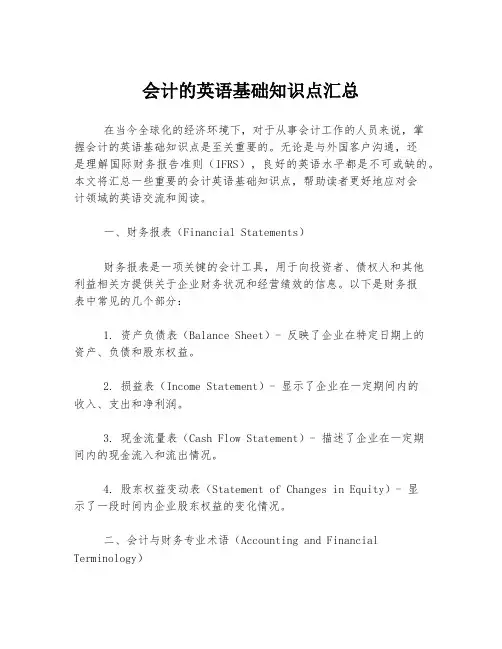
会计的英语基础知识点汇总在当今全球化的经济环境下,对于从事会计工作的人员来说,掌握会计的英语基础知识点是至关重要的。
无论是与外国客户沟通,还是理解国际财务报告准则(IFRS),良好的英语水平都是不可或缺的。
本文将汇总一些重要的会计英语基础知识点,帮助读者更好地应对会计领域的英语交流和阅读。
一、财务报表(Financial Statements)财务报表是一项关键的会计工具,用于向投资者、债权人和其他利益相关方提供关于企业财务状况和经营绩效的信息。
以下是财务报表中常见的几个部分:1. 资产负债表(Balance Sheet)- 反映了企业在特定日期上的资产、负债和股东权益。
2. 损益表(Income Statement)- 显示了企业在一定期间内的收入、支出和净利润。
3. 现金流量表(Cash Flow Statement)- 描述了企业在一定期间内的现金流入和流出情况。
4. 股东权益变动表(Statement of Changes in Equity)- 显示了一段时间内企业股东权益的变化情况。
二、会计与财务专业术语(Accounting and Financial Terminology)在会计领域,存在大量的专业术语需要掌握。
下面是一些常见的术语:1. 资产(Assets)- 公司拥有的经济资源或预计未来可以带来经济利益的权益。
2. 负债(Liabilities)- 公司的债务或义务,需要在未来偿还或履行。
3. 股东权益(Shareholders' Equity)- 公司资产减去负债后,归属于股东的权益。
4. 应收账款(Accounts Receivable)- 公司向客户出售产品或提供服务后,客户应付款项的金额。
5. 应付账款(Accounts Payable)- 公司未付的债务,包括向供应商购买的产品或接受的服务。
6. 摊销(Amortization)- 非物质性资产(如专利)在其使用寿命内按一定方式分期减值的过程。
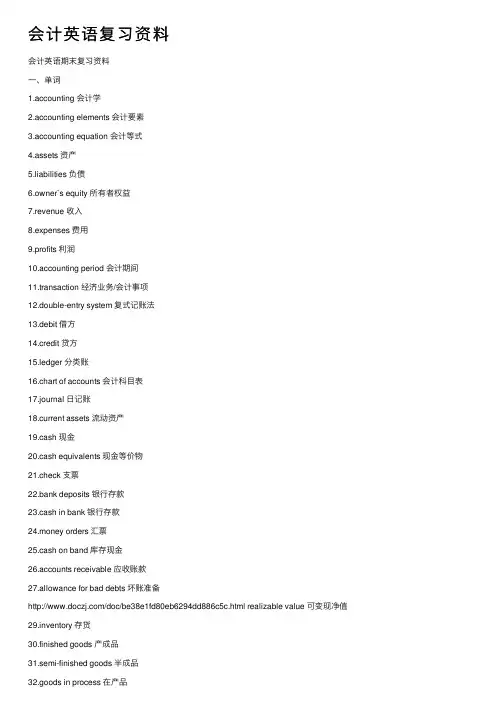
会计英语复习资料会计英语期末复习资料⼀、单词1.accounting 会计学2.accounting elements 会计要素3.accounting equation 会计等式4.assets 资产5.liabilities 负债6.owner`s equity 所有者权益7.revenue 收⼊8.expenses 费⽤9.profits 利润10.accounting period 会计期间11.transaction 经济业务/会计事项12.double-entry system 复式记账法13.debit 借⽅14.credit 贷⽅15.ledger 分类账16.chart of accounts 会计科⽬表17.journal ⽇记账18.current assets 流动资产19.cash 现⾦20.cash equivalents 现⾦等价物21.check ⽀票22.bank deposits 银⾏存款23.cash in bank 银⾏存款24.money orders 汇票25.cash on band 库存现⾦26.accounts receivable 应收账款27.allowance for bad debts 坏账准备/doc/be38e1fd80eb6294dd886c5c.html realizable value 可变现净值29.inventory 存货30.finished goods 产成品31.semi-finished goods 半成品32.goods in process 在产品33.historical cost 历史成本34.specific identification 个别计价法35.first-in, first-out 先进先出法/doc/be38e1fd80eb6294dd886c5c.html st-in, first-out 后进先出法37.weighted average 加权平均法38.raw materials 原材料39.short-term investment 短期投资40.marketable securities 有价证券41.shareholder 股东42.bonds 债券43.debentures 债券44.long-term assets 长期资产45.fixed assets 固定资产46.intangible assets ⽆形资产47.deferred assets 递延资产/doc/be38e1fd80eb6294dd886c5c.html eful life 使⽤寿命49.depreciation 折旧50.depreciable amount 应计折旧额51.depreciation method 折旧⽅法52.estimated net residual value 预计净残值53.straight-line method 直线法54.units of production method ⼯作量法55.double declining balance method 双倍余额递减法56.sum-of-the-years-digits method 年数总和法57.amortization 摊销58.impairment 减值59.current liabilities 流动负债60.accounts payable 应付账款61.notes payable 应付票据62.unearned revenue 预收账款63.income taxes payable 应交所得税64.contingent liabilities 或有负债65.long-term liabilities 长期负债66.bonds payable 应付债券67.ownership 所有权68.sole proprietorship 独资企业69.partnership 合伙企业70.corporation 公司/doc/be38e1fd80eb6294dd886c5c.html mon shareholders 普通股股东72.preferred shareholders 优先股股东/doc/be38e1fd80eb6294dd886c5c.html mon stock 普通股74.preferred stock 优先股75.dividends 股利76.retained earnings 留存收益77.paid-in capital 实收资本78.capital stock 股本79.addtional paid-in capital 附加投⼊资本80.capital surplus 资本公积81.undistributed profit 未分配利润82.par value ⾯值83.fair value 公允价值84.reserve fund 盈余公积85.legal reserve 法定盈余86.stock split 股利分割87.cash dividends 现⾦股利88.stock dividends 股票股利89.sales revenue 销售收⼊90.service revenue 劳务收⼊91.product costs 产品成本92.direct material costs 直接材料成本93.direct labor costs 直接⼈⼯成本94.indirect costs 间接成本95.manufacturing overhead 制造费⽤96.period expenses 期间费⽤97.operating expense 营业费⽤98.administrative expense 管理费⽤99.finance expense 财务费⽤100.balance sheet 资产负债表101.income statement 利润表/损益表102.cash flow statement 现⾦流量表⼆、填空1. The accounting elements include , , , , , and .2. Liabilities are of a business.3. Borrowing cash from a bank does not belong to ; it simply belongs to liability.4. Profit is the of revenue over expenses for the accounting period.5. The accounting equation is : = + .6.“Dr.” stands for debits ,while “Cr.” is the abbreviation for .7. Liability, owner`s equity, revenue and profit decreases are recorded as .8. Short-term investments refer to various of .9. Marketable securities include and to be realized within one year from the balance sheet date and shall be accounted for at cost.10. Depreciation refers to the systematic allocation of the of a fixed asset over its useful life.11. The four common depreciation methods are .12. shall be employed when it is assumed that an asset`s economic revenue is the same each year, and the repair and maintenance cost is also the same for each period.13. When depreciation is mainly due to wear and tear, are usually used.14. The two types of intangible assets are finite and intangibles.15. Please name five most commonly seen intangibles , i.e., , , , , and .16. Intangible assets do not include internally generated , and .17. Intangible assets should be measured initially at .18. For intangible assets with finite useful lives enterprises shall consider their while intangible assets with indefinite useful lives shall not be amortized.19. The account of should be decreased when the service paid for in advancehas been provided.20. The account of should be recorded when the business purchased supplies on credit.21. The account of used to show what the business owes the bank.22. A corporation`s balance sheet contains assets, liabilities, and .23. and are the two common capital stocks issued by a corporation.24. and are the usual forms of distribution to share holders.25. A is a proportional distribution to shareholders of additional shares of the corporation`s common or preferred stocks.26. represents the corporation`s accumulated net income, less accumulated dividends and other amounts transferred to paid-in capital accounts.三、单选1. Matching each of the following statements with its poper term.(1) accounts receivable ( )(2) dishonored notes receivable ( )(3) allowance method ( )(4) direct write-off method ( )A. The method of accounting for un-collectible accounts that provides an expense for un-collectible receivables in advance of their write-off.B. A receivable created by selling merchandise or service on credit.C. A note that maker fails to pay on the due date.D. The method of accounting for un-collectible accounts that recognizes the expense only when accounts are judged to be worthless.2. At the end of the fiscal year, accounts receivable has a balance of $100000 and allowance for doubtful accounts has a balance of $7000, The expected net realizable value of the accounts receivable is ( )A. $7000B. $93000C. $100000D. $1070003. If merchandise inventory is being valued at cost and the price level is steadily rising, the method of costing that will yield the higher net income is ( )A.LIFOB.FIFOC.AverageD.Periodic4. Given the following information, which of the following accounting transactions is true?( )Gross payroll $20000Federal income tax withheld $4000Social security tax withheld $1600A. $1600 is recorded as salary expense.B. $14400 is recorded as salary payableC. The $1600 deducted for employee social security tax belongs to the companyD. Payroll is an example of an estimated liability5.If a corporation has outstanding 1000 shares of $9 cumulative preferred stock of $100 par and dividends have been passed for the preceding three years, what is the amount of preferred dividends that must be declared in the current year before a dividend can be declared on common stock?( )A. $9000B. $27000C. $36000D. $450006. All of the following are reasons for purchasing treasury stock except to ( )A. make a market for the stockB. increase the number of shareholdersC. increase the earnings per share and return on equityD. give employee as compensation7. Paid-in capital for a corporation may arise from which of the following sources?( )A. Issuing cumulative preferred stockB. Receiving donations of real estateC. Selling the corporation`s treasury stockD. All of the above8. Under the equity method, the investment account is decreased by all of the following except the investor`s proportionate share of ( )A. dividends paid by the investeeB. declines in the fair value of the investmentC. the losses of the investeeD. all of the options9. Cash dividends are paid on the basis of the number of shares ( )A. authorizedB. issuedC. OutstandingD. outstanding less the number of treasury shares10. The stockholders` equity section of the balance sheet may include ( )A. common stockB. preferred stockC. donated capitalD. all of the above11. Declaration and issuance of a dividend in stock ( )A. increases the current ratioB. decreases the amount of working capitalC. decreases total stockholders` equityD. has no effect on total assets, liabilities, or stockholders` equity12. If a corporation reacquires its own stock, the stock is listed on the balance sheet in the ( )A. current assets sectionB. long term liability sectionC. stockholders` equity sectionD. investments section13. A corporation has issued 25000 shares of $100 par common stock and holds 3000 of these shares as treasury stock. If the corporation declares a $2 per share cash dividend, what amount will be recorded as cash dividend?( )A. $22000B. $2500014. A company declared a cash dividend on its common stock on December 15, 2004, payable on January 12, 2005. How would this dividend affect shareholders` equity on the following dates? ( ) December 15, January 122004 2005A. Decrease. Decrease.B. No effect. No effect.C. No effect. No effect.D. Decrease. Decrease.15. An example of a cash flow from an operating activity is ( )A. the receipt of cash from issuing stockB. the receipt of cash from issuing bondsC. the payment of cash for dividendsD. the receipt of cash from customers on account16. An example of a cash flow from an investing activity is ( )A. the receipt of cash from the sale of equipmentB. the receipt of cash from issuing bondsC. the payment of cash for dividendsD. the payment of cash to acquire treasury stock17. An example of a cash flow from a financing activity is ( )A. the receipt of cash from customers on accountB. the receipt of cash from the sale of equipmentC. the payment of cash for dividendsD. the payment of cash to acquire marketable securities18. A receivable created by selling merchandise or services on credit. ( )A. accounts receivableB. dishonored notes payableC. allowance methodD. direct write-off method19. At the end of the fiscal year, accounts receivable has a balance of $100000 and allowance for doubtful accounts has a balance of $7000. The expected net realizable value of the accounts receivable is ( )A. $7000B. $93000C. $100000D. $10700020.( ) are valuable resources owned by the entity.C. EquityD. None of them21. Which is intangible asset ( )A. internally generated goodwillB. internally generated publishing titlesC. franchises and licenseD. internally generated brands22.( ) shall be employed when it is assumed that an asset`s economic revenue is the same each year, and the repair and maintenance cost is also the same for each period.A. straight-line methodB. units of production methodC. double declining balance methodD. sum-of-the-years-digits(SYD) method四、判断1. Fixed assets are intangible assets. ( )2. Internally generated goodwill can be viewed as intangible assets. ( )3. Land doesn`t need depreciation and is considered to have an infinite life. ()4. Fixed assets are usually subjected to depreciation. ( )5. Bonds and stocks are classified as intangible assets.( )6. Once the expected useful life and estimated net residual value are determined, they shall not be changed under any circumstances.( )7. When a corporation issues one type of capital stocks, common stocks are always issued. ( )8. Par value is strictly a legal matter, and it establishes the legal capital of a corporation. ( )9. The balance of the additional paid-in capital account represents a gain on the sale of stocks and increases net income. ( )10. A corporation must, by law, pay a dividend once a year. ( )11. Dividends are an expense of a corporation and should be charged to the periodic income. ( )12. Revenue increase owner`s equity. ( )13. Revenue is recognized when we receive cash from the buyers. ( )14. Advertising expense is usually collected as period expense. ( )15. Interest revenue should be measured based on the length of time. ( )16. If revenue exceed expenses for the same accounting period, the entity is deemed to suffera loss. ( )17. Asset = liabilities + Expense. ( )18. Liabilities are debts of a business. ( )19. Borrowing cash from a bank belongs to revenue. ( )20. Increase in asset is recorded in credit side. ( )21. When depreciation is mainly due to wear and tear, straight-line method shall be employed. ( )22. Bonds payable belong to current liabilities.( )23. All fixed assets are depreciable over their limited useful life.( )24. Fixed assets are intangible assets. ( )25. Internally generated goodwill can be viewed as intangible assets. ( )26. Land doesn`t need depreciation and is considered to have an infinite life. ( )五、翻译1. Accounting contains elements both of science and art. The important thing is that it is not merely a collection of arithmetical techniques but a set of complex processes depending on and prepared for people.2. Inventories refer to merchandise, finished goods, semi-finished goods, goods in process, and all kinds of materials, fuels, containers, low-value and perishable articles and so on that stocked for the purpose of sale, production or consumption during the production operational process, Inventories are normally accounted for at historical cost, as the cost principle requires. Normally, a company may account inventories under the following methods:(1)Specific identification (2)first-in, first-out(FIFO) (3)last-in, first-out(LIFO) (4)weighted average3. In contrast to current assets, long-term assets refer to those assets that will be realized or consumed within a period longer than one year of their acquisition, which are normally divided into fixed assets, intangible assets and deferred assets.Fixed assets refer to the assets whose useful life is over one year, unit value is above the prescribed criteria and where original physical form remains during the process of utilization.4. Depreciation is defined as the accounting process of systematically allocating the depreciable amount of a fixed asset over its useful life by a selected depreciation method. When calculating the depreciation expense of a fixed asset, an enterprise should consider its depreciable amount,estimated net residual value, estimated useful life, and the depreciation methods.5. The amount of retained earnings represents the cumulative net income of the firm since its beginning, less the total dividends that have been distributed to shareholders. It is important to note that retained earnings are not the assets, but the existence of retained earnings means that net assets generated by profitable operations have been kept in the company to help it grow or to meet other business needs. However, a credit balance in Retained Earnings does not mean that cash or any designated set of assets is directly associated with retained earnings. The fact that earnings have been retained means that net assets as a whole have been increased.6. In China, companies must provide “legal reserve.”Today in USA, appropriations of retained earnings are seldom seen on balance sheets.7. Revenue is the gross inflow of economic benefits arising in the course of the ordinary activities of an enterprise from such events as the sale of goods, the rendering of service and the use of enterprise by others. Revenue growth is an important indicator of the market reception of a company`s products and services.8. Sales revenue arises from the sale of goods.Service revenue arises from the rendering of services.9. Expenses refer to the outlays incurred by an enterprise in the course of production and operation. It means the outflows or other using up of assets or incurrence of liabilities during a period. According to the relationship with products, we can divide expenses into two categories: product costs and period expense.Product costs are directly related to the products, which are composed of direct material costs, direct labor costs and the indirect costs.10. Period expenses are not directly associated with products, but they are indispensable for generating the current revenue.11. A balance sheet is a summary of a company`s balances. Assets, liabilities and owner`s equity are listed as of a specific date, such as the end of its financial year. A balance sheet is often described as a snapshot of a company`s financial condition.12. The income statement is a financial statement that summarizes the results of a company`s operation by matching revenue and related expenses for a particular accounting period. It shows the net income or net loss. It is also called earnings statement, statement of operations, and profit and loss statement.13. The cash flow statement is a financial statement that reports the cash receipts and cash payments of an entity during a particular period. The term cash refers not only to the bills and coins we normally think of as cash, but also to cash equivalents. Cash equivalents are highly liquid short-term investment that can easily and quickly be converted into cash, usually with maturity of three months or less at the date of purchase.The cash flows of an entity usually come from cash flows from operating activities, cash flows from investing activities, and cash flows from financing activities.14. Assets are economic resources that are possessed or controlled by an enterprise to generate revenue to the enterprise. Assets of an enterprise are usually divided into the following categories: current assets, long-term investment, fixed assets, intangible assets and other assets. Current assets are assets that will be realized or consumed within one year or within an operating cycle. Typical current assets include cash, bank deposit, accounts receivables and so on. Cash is listed first of all current assets because it is the most liquid of all assets.15. Long-term liabilities are obligations of business that are due to be paid after one year or beyond the operating cycle, whichever is longer. Decisions related to long-term debt are critical because how a company finances its operations is the most important factor in the company`s long-term liability. The amount and type of debt a company incurs depends on many factors, including the nature of the business, its competitive environment, the state of the financial markets, and the predictability of its earnings.六、业务题1.(1)According to the above information, use weighted-average method and the ending inventory should be(2)According to the above information, use LIFO method, the most assigned to the sold should be(3)According to the above information, use FIFO method, the cost assigned to the sold should be(4)According to the above information, use LIFO method, the cost assigned to the ending inventory is2.(1)On June 5, K. Company purchased $6000 of inventory, paying cash.(2)On June 10, K. Company received $10000 of good sales.(3)On June 12, K. Company paid $5000 in salaries by bank deposit.(4)Bought office furniture from Simple Company on account, $30000(5)On June 30, K. Company paid $10000 to Simple Company on account.3. Record each transaction in the accompanying account of L & T Co.(1) Bought supplies on account for $600.(2) Bought equipment for $2700, paying one third down and owing the balance.(3) Gave a note in settlement of transaction (2).(4) Received $500 as an income.4. Record the following entries in the general journal for Stephens Cleaning Company.(1) Invested $10000 cash in the business.(2) Paid $2000 for office furniture.(3) Bought equipment costing $6000 on account.(4) Received $2200 in cleaning income.(5) Paid a quarter of the amount owed on the equipment.5.(1)Accounting to the following information, use weighted-average method and the ending inventory should be(2)Using the information from question(1), the LIFO method, the cost assigned to the ending inventory is6.Assuming that net purchase cost $250000 during the year and that the ending stock was $4000 less than the beginning stock of $30000, the cost of goods would be7. Emily started her business-Emily`s Bakery. The transaction in the year of 2008 are as follow.(1) Emily contributed $10000 in cash.(2) The company borrowed $3000 from a bank.(3) The company purchased equipment for $5000 cash.(4) The company performed service for $12000. The customer paid $8000 in cash and promised to pay the rest amount at a later date.(5) The company paid $9000 for expenses (wages, interest and maintenance)(6) The company paid dividend of $1000.The balance sheet of Emily`s bakeryDecember31, 2008Current Assets Current LiabilitiesLong-term Assets Long-term LiabilitiesOwner`s equityTotal Assets Total Liabilities and Owner`s Equity七、例题1.1 During the month of January, Ted Lott, a lawyer(1) Invested $8000 to open his practice.(2)Bought office supplies (stationery, forms, pencils, and so on)for cash, $700.(3) Bought several pieces of office furniture from Ferraro Furniture Company on account, $2000.(4) Receive $3500 in service fees earned during the month.(5) Paid office rent for January, $600.(6) Paid salary for part-time help, $800.(7) Paid $1600 to Ferraro Furniture Company on account.(8) After taking inventory at the end of the month, Lott found that he had used $200 worth of supplies.(9) Withdrew $470 for personal use.2.1 ABC Company had the following transaction in 2007.(1) Recognized $5000 of sales revenue earned on account.(2) Collected $3000 cash from accounts receivable.(3) Recognized $500 of bad debt expense for accounts receivable that are expected to be un-collectible in the future.2.3 Assume that ABC Company is a listed company. Simple buys 10000 shares of ABC Company`s common stock in New York Securities Exchange on November 1, 2007, at the price of $20 per share.2.4 (1) Assume that, on March 15, 2008, ABC company declared that they decided to give dividends at S3 per common stock. Thus, Simple Company would receive $30000 of dividend. At this time the cash was not given but an accounting record was requested.(2) On April, Simple Company received $30000 of cash dividend. So they need a new accounting record.4.1 Simple Company buys goods for $50000 on credit. The journal entry in Simple Company`s accounting records for this transaction.4.2 (1) On March 1, Simple Company borrows $40000 from its bank for a period of six months at an annual interest rate of 10%. Six months later on September 1, Simple Company will have to pay the bank the principal amount of $40000 plus $2000 interest. As an evidence of this loan, the bank requires Simple Company to issue a note payable. The journal entry in Simple Company`s accounting records for this March 1 borrowing is as follow.(2) Borrowed $40000 for six months at 10% interest per year.(3) The entry on September 1 to record payment of the note will be as follow.4.3 (1) Simple Company signed up a contract with another company to perform services. Simple Company received an advanced cash payment in the amount of $20000 and the term of the contract was one month. The transaction acts to increase assets (cash) and liabilities (unearned revenue). The journal entry in Simple Company`s accounting records for this transaction is as follow.(2) At this time, Simple Company received cash but didn`t perform the services. So the cash of $20000 was not the real revenue. Only when Simple Company performed the services, a new journal entry would be made in the follow.4.4 Bonds issued at a discountAssume that ABC Company plans to issue $1000000 face value of 10%, 10-year bonds. At the issuance date of May 1, the going market rate of interest is slightly above 10% and the bonds sell at a market price of only $950. The issuance of the bonds will be recorded by the following entry.4.5 In this example, the discount on bonds payable has a beginning debit balance of $50000. Each year $5000 will be amortized into Bond Interest Expense.Assuming that the interest payment dates are October 31 and April 30, the entries to be made each six months to record bond interest expense are as follow.(1) Paid semi-annual interest on $1000000 of 10%, 10-year bonds.(2) Amortized discount for six months on 10-year bond issue ($50000/20=$2500)5.1On January 1, Joan Adams and Richard Brown decide to form a partnership by consolidating their two retail stores. A capital account will be opened for each partner and credited, with the agreed valuation of the net assets that the partner contributes. The journal entries to open the accounts of the partnership of Adams and Brown are as follow.(1) To record the investment by Joan Adams in the partnership of Adams and Brown.(2) To record the investment by Richard Brown in the partnership of Adams and Brown.(3) After six months of operation the firm is in need of more cash, and the partners make additional investments of $10000 each on July 1. These additional investments are credited to the capital accounts as shown below.5.3 Adams and Brown have agreed to share profits equally. Assuming that the partnership earns net income of $60000 in the first year of operations, the entry to close the income summary account is as follow.(1) To divide net income for the year in accordance with partnership agreement to share profits equally.The next step in closing the accounts is to transfer the balance of each partner`s drawing account to his capital account. Assuming that withdrawals during the year amounted to $24000 for Adams and $16000 for Brown, the entry at December 31 to close the drawing accounts is as follow.(2) To transfer debit balances in partner`s drawing accounts to their respective capital accounts.5.4 The issuance of 100000 shares of common stock, par $1, for cash of $1.2 per share would be recorded as follow.5.5 Assume that a corporation issues 10000 shares of no-par common stock at $40 a share and ata later date issues 1000 additional shares at $36. The entries to record the no-par stock are as follow.(1) Issued 10000 shares of no-par common stock at $40.(2) Issued 1000 shares of no-par common stock at $36.5.6 Assume that a corporation has a balance of $300000 in retained earnings and 50000 shares of $10 par value common stock. The current fair market value of its stock is $15 per share.(1) If the corporation declares a 10% stock dividend, the entry to record this transaction at the declaration and payment date is as follow.(2) If the corporation declares a 40% stock dividend, the entry to record this transaction at the declaration and payment date is as follow.5.7 Assume that on December 1,2005, the directors of A corporation declare a 40 cents per share cash dividend on 100000 shares of $10 par value common stock. The dividend is $40000 (100000*0.4).(1) the entry to record the declaration is as follow.(2) At the end of the year, the dividends account is closed to retained earnings by the following entry.⼋、附加题1.Whether an account is to be debited or credited depends on the accounting elements. By convention, increases in assets and expenses are recorded as debits, whereas increases in liability, owner`s equity, revenue and profit are recorded as credits. Assets and expense decreases are recorded as credits, whereas liability, owner`s equity, revenue and profit decreases are recorded as debits.2.In an accounting system, a separate account is designated for each asset, each liability, and each component of owner`s equity, including revenues and expenses. That`s to say, accounts are grouped according to accounting elements. These groups of accounts are called the ledger.3. The chart of accounts is a listing of the accounts by title and number. Assets and liability accounts are arranged according to their liquidity. While income, expense and owner`s equity accounts are listed according to their importance.4.A business`s accounts receivable are the amounts that its customers owe it and these accounts receivable are sometimes called trade creditors.Allowance for bad debts is the estimated amount of accounts receivable that will not be collected.The net realizable value is the amount that a company is actually expecting to get in the future. Net realizable = accounts receivable — allowance for bad debts4. Short-term investments refer to various marketable securities, which can be realized at any time and will be held less thana year, as well as other investment with a life of no longer thana year.。
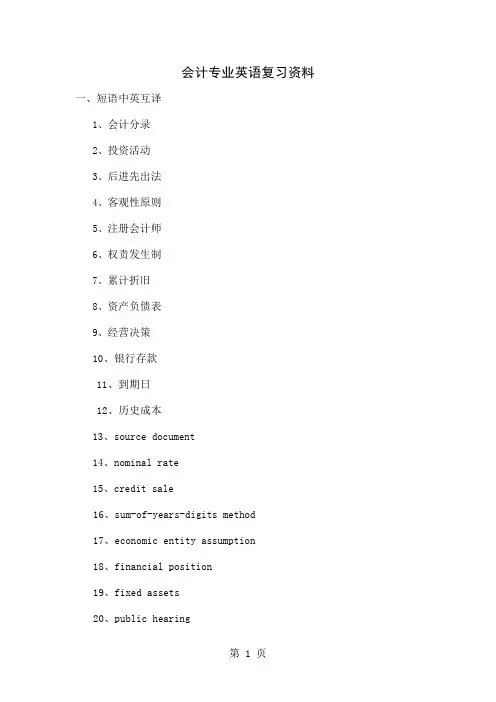
会计专业英语复习资料一、短语中英互译1、会计分录2、投资活动3、后进先出法4、客观性原则5、注册会计师6、权责发生制7、累计折旧8、资产负债表9、经营决策10、银行存款11、到期日12、历史成本13、source document14、nominal rate15、credit sale16、sum-of-years-digits method17、economic entity assumption18、financial position19、fixed assets20、public hearing21、income statement22、sales discount23、value added tax24、trade mark25、bank overdraft二、从下列选项中选出最佳答案1、Generally,revenue is recorded by a business enterprise at a pointwhen :( )A、Management decides it is appropriate to do soB、The product is available for sale to consumersC、An exchange has taken place and the earning process isvirtually completeD、An order for merchandise has been received2、Why are certain costs capitalized when incurred and then depreciated or amortized over subsequent accounting periods?( )A、To reduce the income tax liabilityB、To aid management in making business decisionsC、To match the costs of production with revenue as earnedD、To adhere to the accounting concept of conservatism3、What accounting principle or concept justifies the use of accruals and deferrals?( )A、Going concernB、MaterialityC、ConsistencyD、Stable monetary unit4、An accrued expense can best be described as an amount ( )A、Paid and currently matched with revenueB、Paid and not currently matched with revenueC、Not paid and not currently matched with revenueD、Not paid and currently matched with revenue5、Continuation of a business enterprise in the absence of contrary evidence is an example of the principle or concept of ( )A、Business entityB、ConsistencyC、Going concernD、Substance over form6、In preparing a bank reconciliation,the amount of checks outstanding would be:( )A、added to the bank balance according to the bank statement.B、deducted from the bank balance according to the bank statement.C、added to the cash balance according to the depositor’s records.D、deducted from the cash balance according to the depositor’srecords.7、Journal entries based on the bank reconciliation are requiredfor:( )A、additions to the cash balance according to the depositor’srecords.B、deductions from the cash balance according to the depositor’srecords.C、Both A and BD、Neither A nor B8、A petty cash fund is :( )A、used to pay relatively small amounts。
商誉goodwill 有形资产Tangible assets 处置disposal 摊销amortization固定资产Plant assets/Property plant and equipment/Fixed assets 股东Shareholder直线法Straight-line method 双倍余额递减法Double-declining-balance method年数总和法Sum-of-the-years’-digits method房地产中介Real estate broker定率递减余额法fixed-percentage-of-declining-balance method付款服务费用Escrow fee累计折旧Accumulated depreciation资产净值Book value/Carrying amount减值Impairment资本化Capitalize会计主体假设Business entity assumption公认会计准则GAAP(general accepted accounting principal)会计分期假设Time period assumption国际会计准则委员会IASB(international accounting standard board) 透支Bank overdraft国际会计准则IFRS(international financial reporting standard)持续经营假设Going concern assumption 内部审计Internal auditor货币计量假设Monetary unit assumption 历史成本原则Cost principal存deposit 取Withdrowal 收入确认原则Revenue recognition principle 配比原则Matching principal 汇率Exchange rate全面披露原则Full disclosure principal 会计恒等式accounting equation 背书Endorsement现金收据Cash receipt现金支出Cash disbursement 现金余额Cash balance筹资活动Financial activities经营活动Operating activities投资活动Investing activities应纳税所得Taxable income一般管理经费overhead 本金额Principal amount现值Present value股利、红利dividend 留存收益Retained earning 合同contract审计报告Audit report/auditor’s report佣金commission 支票本Checkbook 支票存根Check stubs 借/贷通知单Debit/Credit memorandom银行记账单Bank statement应收票据Notes receivable 经营周期Operating cycle直接核销法Direct write off method 备抵法Allowance method坏账准备Allowance for Doubtful Accounts 销售百分比法Percentage of sale应收账款百分比法Percentage of receivable 账龄分析法Aging of the accounts receivable到期日Maturity date(due day) 加权平均Weighted average (average cost)先进先出First-in, first-out(FIFO)后进先出Last-in, first-out(LIFO)可识别无形资产Identifiable intangible assets:Indentifiable intangible assets are those intangibles that can be purchased or sold separately from the other assets of the company.折旧Depreciation is the systematic allocation of the depreciable amount of an asset over its useful life.可实现净值Net realisable value is the estimated selling price in the ordinary course of business less the estimated costs of completion and the estimated costs necessary to make the sale.权责发生制Accrual basis accounting:An accounting method that records financial events based on economic activity rather financial activity. Under accrual accounting revenue is recorded when it is earnd and realized, regardless of when actual payment is received.会计Accounting may be described as the process of identifying, measuring, recording, and communicating economic information to permit informed judgments and decisions by users of that information.An asset is a resource controlled by the enterprise as a result of past events and from which future economic benefits are expected to flow to the enterprise.现金cash:Accountants define cash as money on deposit in banks and any items that a bank will accept for deposit.企业已付银行未付Outstanding checks:Checks issued and recorded by the company but not yet presented to the bank for payment.应收账款Accounts receivable:Accounts receivable are liquid assets, usually being converted into cash within a period of 30 to 60 days.收入Revenue:Revenue is the gross inflow of economic benefits during the period arising in the course of the ordinary activities of an entity when those inflows result in increase in equity, other than increases relating to contributions from equity participants.收益应按照实收款项和应收款项的公允价值计算.Revenue shall be measured at the fair value of the consideration received or receivable.交易中所产生的收益一般是按照会计主体和资产购买或使用双方的协议决定的.The amount of revenue arising on a transaction is usually determined by agreement between the entity and the buyer or user of the asset.存货应该按照”成本”和”可实现净值”底的计算Inventories shall be measured at the lower of cost and net realisable value.存货包括那些买入是以卖出为目地的物品. 比如, 零售商买入机器设备是为再销售, 或者那些为了出售而买入的土地和其他的房产.Inventories encompass goods purchased and held for resale including, for example, merchandise purchased by retailer and held for resale, or land and other property held for resale.存货成本应该包括所有购买的费用, 生产的费用和其他那些发生在使存货转移到目前地点和状态的费用.the cost of inventories shall comprise all costs of purchase, costs of conversion and other costs incurred in bringing the inventories to their present location and condition.资产净值:Carrying amount is the amount at which an asset is recognised after deducting any accumulated depreciation and accumulated impairment losses.折旧:Depreciation is the systematic allocation of the depreciable amount of an asset over its useful life.残值:The residual value is the estimated amount that an entity would currently obtain from disposal of the asset, after deducting the estimated costs of disposal, if the asset were already of the age and in the condition expected at the end of its useful life.Amortisation is the systematic allocation of the depreciable amountof an intangible asset over its useful life.开发:开发是指在进行商业性的生产或使用前,将研究成果或其他知识应用于某项计划或设计,以生产出新的或具有实质性改进的材料,装置,产品,工艺,系统或服务。
会计笔记英语知识点大全会计是一门重要的商科学科,会计笔记是会计学习中的重要组成部分。
在学习会计的过程中,掌握会计笔记的英语知识点对于提高学习效果和职业发展都有很大帮助。
本文将为您介绍会计笔记英语知识点的大全,希望对广大会计从业人员和学生有所帮助。
一、基本会计概念的英语表达1. 会计 (Accounting)会计是一门记录、分类和分析财务信息的学科。
2. 账户 (Account)账户是用于记录和汇总相关财务信息的记录单元。
3. 资产 (Asset)资产是企业所拥有的可预期经济利益。
4. 负债 (Liability)负债是企业所欠他人的债务。
5. 所有者权益 (Equity)所有者权益是企业所拥有的资产减去负债后所剩余的权益。
6. 收入 (Revenue)收入是企业在销售商品或提供服务时所获得的经济利益。
7. 支出 (Expense)支出是企业为取得收入而发生的或与经营业务有关的费用。
二、会计科目的英语表达1. 资产科目 (Asset Accounts)资产科目包括现金、应收账款、存货、固定资产等。
2. 负债科目 (Liability Accounts)负债科目包括应付账款、长期负债等。
3. 所有者权益科目 (Equity Accounts)所有者权益科目包括股东投资、净利润等。
4. 收入科目 (Revenue Accounts)收入科目包括销售收入、服务收入等。
5. 支出科目 (Expense Accounts)支出科目包括工资支出、租金支出等。
三、会计凭证的英语表达1. 借方 (Debit)借方是会计凭证上记载“增加”或“支出”的一方。
2. 贷方 (Credit)贷方是会计凭证上记载“减少”或“收入”的一方。
3. 手工记账 (Manual Accounting)手工记账是指使用纸质或电子表格进行会计凭证录入的操作。
4. 自动记账 (Automated Accounting)自动记账是指使用会计软件或系统进行会计凭证录入的操作。
Unit 1Financial information about a business is needed by many outsiders .These outsiders include owners, bankers, other creditors, potential investors, labor unions, government agencies ,and the public ,because all these groups have supplied money to the business or have some other interest in the business that will be served by information about its financial position and operating results.许多企业外部的人士需要有关企业的财务信息,这些外部人员包括所有者、银行家、其他债权人、潜在投资者、工会、政府机构和公众,因为这些群体对企业投入了资金,或享有某些利益,所以必须得到企业财务状况和经营成果信息。
Unit 2Each proprietorship, partnership, and corporation is a separate entity.每一独资企业、合伙企业和股份公司都是一个单独的主体。
In accrual accounting, the impact of events on assets and equities is recognized on the accounting records in the time periods when services are rendered or utilized instead of when cash is received or disbursed. That is revenue is recognized as it is earned, and expenses are recognized as they are incurred – not when cash changes hands .if the cash basis accounting were used instead of the accrual basis, revenue and expense recognition would depend solely on the timing of various cash receipts and disbursements.Unit 3During each accounting year ,a sequence of accounting procedures called the accounting cycle is completed.在每一会计年度内,要依次完成被称为会计循环的会计程序。
《会计英语》复习资料二、单项选择(红字为正确答案):Financial reports are used byd、all of the above1、 For accounting purposes, the business entity should be considered separate from its owners if the entity is()d、all of the above2、 Which of the following best describes accounting?b、is an information system that provides reports to stakeholders3、 Using accrual accounting, expenses are recorded and reported onlya、when they are incurred, whether or not cash is paid4、 The measurement bases exclude( )c、Sale price5、 Debts owed by a business are referred to as()d、liabilities6、 Which of the following financial statements reports information as of a specific date?c、balance sheet7、 Cash investments made by the owner to the business are reported on the statement of cash flows in thea、financing activities section8、 The accounting equation may be expressed asd、Assets - Liabilities = Owner's Equity9、 Which of the following groups of accounts have a normal credit balance?a、revenues, liabilities, capital10、 Which of the following groups of accounts have a normal debit balance?d、assets, expenses11、 Which of the following types of accounts have a normal credit balance?c、revenues and liabilities12、 In the accounting cycle, the last step is()a、preparing a post-closing trial balance13、 Which of the following should not be considered cash by an accountant?c、postage stamps14、 A bank reconciliation should be prepared periodically because ()c、any differences between the depositor's records and the bank's recordsshould be determined, and any errors made by either party should bediscovered and corrected15、 The amount of the outstanding checks is included on the bank reconciliation as a(n) ()c、deduction from the balance per bank statement16、 The asset created by a business when it makes a sale on account is termedc、accounts receivable17、 What is the type of account and normal balance of Allowance for Doubtful Accounts?a、Contra asset, credit18、 The term "inventory" indicates ()d、both A and B19、 Merchandise inventory at the end of the year was understated、 Which of the following statements correctly states the effect of the error?a、net income is understated20、Merchandise inventory at the end of the year is overstated、 Which of the following statements correctly states the effect of the error?b、owner's equity is overstated21、The inventory method that assigns the most recent costs to cost of good sold isb、LIFO22、Under which method of cost flows is the inventory assumed to be composed of the most recent costs?b、first-in, first-out23、 When the perpetual inventory system is used, the inventory sold is debited to ( )b、cost of merchandise sold24.All of the following below are needed for the calculation of depreciation exceptd、book value25、 A characteristic of a fixed asset is that it isb、used in the operations of a business26、 Accumulated Depreciation ( )c、is a contra asset account27、 The two methods of accounting for investments in stock are the cost method and the ()b、equity method28、 A capital expenditure results in a debit to ()d、an asset account29、 Current liabilities are()d、due and payable within one year30、 The debt created by a business when it makes a purchase on account is referred to as anb、account payable31、 Notes may be issued ()d、all of the above32、The cost of a product warranty should be included as an expense in thec、period of the sale of the product33、 If the market rate of interest is 8%, the price of 6% bonds paying interest semiannually witha face value of $100,000 will bec、Less than $100,00034、 The interest rate specified in the bond indenture is called the ()b、contract rate35、 When the corporation issuing the bonds has the right to repurchase the bonds prior to the maturity date for a specific price, the bonds ared、callable bonds36、 When the market rate of interest on bonds is higher than the contract rate, the bonds will sell atd、 a discount37、 One potential advantage of financing corporations through the use of bonds rather than common stock isc、the interest expense is deductible for tax purposes by the corporation38、 Characteristics of a corporation include ()d、shareholders who have limited liability39、 Stockholders' equity ()c、includes retained earnings and paid-in capital40、 The excess of issue price over par of common stock is termed a(n) ()d、premium41、 Cash dividends are usually not paid on which of the following?c、treasury stock42、 Which of the following accounts below is reported in the paid-in capital/stockholders' equity section of the corporate balance sheet?d、Preferred Stock43、 If preferred stock has dividends in arrears, the preferred stock must bed、convertible44、 The primary purpose of a stock split is tob、reduce the market price of the stock per share45、 Which statement below is not a reason for a corporation to buy back its own stock、d、to increase the shares outstanding46、 The liability for a dividend is recorded on which of the following dates?d、the date of declaration47、 In credit terms of 2/10, n/30, the "2" represents thed、 percent of the cash discount48、 Revenue should be recognized when()b、the service is performed49、 The ability of a business to pay its debts as they come due and to earn a reasonable amount of income is referred to as ()b、solvency and profitability50、 Which of the following is not included in the computation of the quick ratio?a、inventory四、问答题:3.Differentiate between financial accounting and managerial accounting、财务会计与管理会计得区别。
会计英语期末知识点汇总会计是一门涉及记录、报告和分析财务数据的学科。
在全球范围内,英语是会计领域的共通语言。
掌握会计英语是会计专业学生的基本要求。
为了帮助大家复习期末考试,本文将汇总一些会计英语的重要知识点。
1. 财务报表财务报表是记录和反映一个企业财务状况、经营业绩的文件。
常见的财务报表包括资产负债表、利润表和现金流量表。
1.1 资产负债表(Balance Sheet)资产负债表展示了一个企业在特定日期的资产、负债和所有者权益。
其中,资产包括固定资产、流动资产等;负债包括短期负债、长期负债等;所有者权益是指企业资产减去负债后剩余的部分。
1.2 利润表(Income Statement)利润表显示了一个企业在特定期间内的营业收入、营业成本、税前利润和净利润。
利润表反映了一个企业的盈亏情况。
1.3 现金流量表(Cash Flow Statement)现金流量表记录了一个企业在特定期间内的现金流入和流出情况。
它分为经营活动、投资活动和筹资活动三个部分。
2. 会计原则和概念2.1 会计原则(Accounting Principles)会计原则是会计行业的标准规范,确保财务报表的准确性和可比性。
常见的会计原则包括实体概念、会计周期概念、成本概念等。
2.2 会计概念(Accounting Concepts)会计概念是会计原则的细化和解释。
常见的会计概念包括货币计量、持续性、历史成本等。
3. 账户和分类3.1 资产账户(Asset Accounts)资产账户是用来记录企业拥有的资源,如现金、存货、应收账款等。
3.2 负债账户(Liability Accounts)负债账户是用来记录企业所欠的债务,如应付账款、短期借款等。
3.3 所有者权益账户(Equity Accounts)所有者权益账户用来记录企业的资本和所有者的权益,如股本、留存收益等。
3.4 收入账户(Revenue Accounts)收入账户用来记录企业的收入来源,如销售收入、利息收入等。
会计英语知识点总结会计英语是指在会计领域中使用的专业术语和表达方式。
对于从事会计工作的人员来说,掌握会计英语是十分重要的,因为它涉及到了财务报表的编制、财务分析以及财务管理等方面。
在这篇文章中,我将总结一些常见的会计英语知识点,以帮助读者更好地掌握这一领域的语言表达。
一、会计核算方法(Accounting Methods)1. 现金会计法(Cash Accounting Method)现金会计法是指只在货币实际发生时才予以认可和记录的会计核算方法。
它适用于小型企业和个人,记录的是实收实付的现金流量。
2. 计提法(Accrual Accounting Method)计提法是指按照货币应收和应付的实际发生情况进行会计记账,无论是否收付现金。
这种方法更加符合企业的真实经济状况,广泛应用于大型企业和上市公司。
二、财务报表(Financial Statements)1. 资产负债表(Balance Sheet)资产负债表是企业在特定日期上的财务状况的快照。
它将企业的资产、负债和所有者权益进行了统计,并展示了企业的资金来源和运用情况。
2. 利润表(Income Statement)利润表反映了企业在一定期间内的经营业绩。
它列出了企业的收入、成本以及税前和税后利润等财务指标。
3. 现金流量表(Cash Flow Statement)现金流量表显示了企业在一定期间内现金流动的情况。
它列出了企业的经营、投资和筹资活动所产生的现金流量净额。
三、财务指标(Financial Ratios)1. 流动比率(Current Ratio)流动比率是企业流动性的重要指标之一,它反映了企业流动资产与流动负债的关系。
公式为:流动比率= 流动资产/ 流动负债。
该指标越高,说明企业越有能力偿还短期债务。
2. 负债比率(Debt Ratio)负债比率是企业资本结构的重要指标,它反映了企业负债占总资产的比例。
公式为:负债比率= 总负债/ 总资产。
会计专业英语复习资料一、短语中英互译1、会计分录2、投资活动3、后进先出法4、客观性原则5、注册会计师6、权责发生制7、累计折旧8、资产负债表9、经营决策10、银行存款11、到期日12、历史成本13、source document14、nominal rate15、credit sale16、sum-of-years-digits method17、economic entity assumption18、financial position19、fixed assets20、public hearing21、income statement22、sales discount23、value added tax24、trade mark25、bank overdraft二、从下列选项中选出最佳答案1、Generally,revenue is recorded by a business enterprise at a pointwhen :( )A、Management decides it is appropriate to do soB、The product is available for sale to consumersC、An exchange has taken place and the earning process is virtuallycompleteD、An order for merchandise has been received2、Why are certain costs capitalized when incurred and then depreciated or amortized over subsequent accounting periods?( )A、To reduce the income tax liabilityB、To aid management in making business decisionsC、To match the costs of production with revenue as earnedD、To adhere to the accounting concept of conservatism3、What accounting principle or concept justifies the use of accruals and deferrals?( )A、Going concernB、MaterialityC、ConsistencyD、Stable monetary unit4、An accrued expense can best be described as an amount ( )A、Paid and currently matched with revenueB、Paid and not currently matched with revenueC、Not paid and not currently matched with revenueD、Not paid and currently matched with revenue5、Continuation of a business enterprise in the absence of contrary evidence is an example of the principle or concept of ( )A、Business entityB、ConsistencyC、Going concernD、Substance over form6、In preparing a bank reconciliation,the amount of checks outstanding would be:( )A、added to the bank balance according to the bank statement.B、deducted from the bank balance according to the bank statement.C、added to the cash balance according to the depositor’s records.D、deducted from the cash balance according to the depositor’s records.7、Journal entries based on the bank reconciliation are required for:( )A、additions to the cash balance according to the depositor’s records.B、deductions from the cash balance according to the depositor’srecords.C、Both A and BD、Neither A nor B8、A petty cash fund is :( )A、used to pay relatively small amounts。
B、established by estimating the amount of cash needed for disbursementsof relatively small amounts a specified period。
C、reimbursed when the amount of money in the fund is reduced topredetermined minimum amount。
D、all of the above。
9、A corporation has two equity securities,which it holds as a temporary investment.If security A has a cost of $150,000 and a fair market value of $120,000,security B has a cost of $200,000 and a fair market value of $150,000, at what amount should these securities be reported in the current assets section of the corporation’s balance sheet? ( )A、$350,000B、$320,000C、$300,000D、$270,00010、Under what caption would an investment in stock that is hold as a temporary investment be reported in the balance sheet?( )A、Current assetsB、Plant assetsC、InvestmentsD、None of the above11、If the merchandise inventory at the end of the year is overstated by $7,500 the error will cause an :A.overstatement of cost of merchandise sold for the year by $7,500B.understatement of gross profit for the year by $7,500C.overstatement of net income for the year by $7,500D.understatement of net income for the year by $7,50012.The inventory system employing accounting records that continuously disclose the amount of inventory is called: ( )A.periodicB.perpetualC.physicalD.retail13.The inventory costing method that is based on the assumption that costs should be charged against revenue in the order in which they were incurred is: ( )A.FIFOB.LIFOC.average costD.perpetual inventory14.If merchandise inventory is being valued at cost and the price level is rising ,the method of costing that will yield the largest net income is : ( )A.FIFOB.LIFOC.averageD.periodic15.If a firm purchases $100,000 of bonds of Xcompany at 101 plus accrued interest of $2,000 and pays broker’s commissions of $50,the amount debited to Investment in X Company Bonds may be: ( )A.$100,000B.$101,050C.$103,000D.none of the above16.The owner’s equity in a corporation is commonly called: ( )A.capitalB.stockholders’ equityC.shareholders’ investmentD.all of the above17.If a corporation reacquires its own stock ,the stock is listed on the balance sheet in the : ( )A.current assets sectionB.long-term liabilities sectionC.stockholders’ equity sectionD.none of the above18.Paid-in capital for a corporation may originate from which of the following sources? ( )A.Real estate donated to the corporationB.Redemption of the corporation’s own stockC.Sale of the corporation’s treasury stockD.all of the above19.During its first year of operations,a corporation elected to use the straight-line method of depreciation for financial reporting purposes and the sum-of-the-years-digits method in determining taxable income.If the income tax rate is 45% and the amount of depreciation expense is $60,000 under the straight-line method and $100,000 under thesum-of-the-years-digits method,what is the amount of income tax deferred to future years? ( )A.$18,000B.$27,000C. $45,000D.none of the above20.An appropriation for plant expansion would be reported on the balance sheet in : ( )A.the plant assets sectionB.the long-term liabilities sectionC.the stockholders’equity sectionD.none of the above三.判断题,正确的写”T”.错误的写”F”1. Many people have chosen accounting as a profession because of itsmany disadvantages. ( )2.Accounting may be specialists in one of many fields of expertise such as auditing, budgeting, taxation, or financial reporting. ( )3.The accounting equation is : Assets =Owners' equity. ( )4.The accounting equation is: Assets = liabilities +Equities. ( )5.In accounting, the left side is called debit, abbreviated "Cr ", and the right side is called the credit, abbreviated "Dr ".( )6.The words "to debit" and "to credit" are the same. ( )7.In order to reflect the changes of the accounting objectives clearly, we should divide them into four kinds---Assets, liabilities, Owners' equity and Loss, etc. ( )8.Most business have many same accounts. ( )9.The recording voucher should be divided into three kinds—the receipt, payment and transfer voucher. ( )10.Vouchers of accounting is including the original voucher. ( )四、经济业务描述题1.On January 1, the owner of Ann’s Delivery Service Company, Ann Moe,invested $25,000 cash to get the business started.2.On January 3, the business purchased office equipment on accountfor $1500.3.On January 5, office supplies are purchased for $450 cash.4.On January 10, the company paid $700 toward what was owed on aprevious obligation.5.On January 12, delivery services were performed which resulted indelivery fees for $500, which will be paid in two weeks.6.On January 15, the business borrows $4,000 at the bank, giving a30 day note.7.On January 17, the owner withdrew $200 cash for personal use.8.On January 20, delivery services are rendered for $2,500 cash..五、段落中英互译1.业主权益被定义为资产总额对负债总额的超出额,这一余额代表业主在企业中的权益的账面价值。